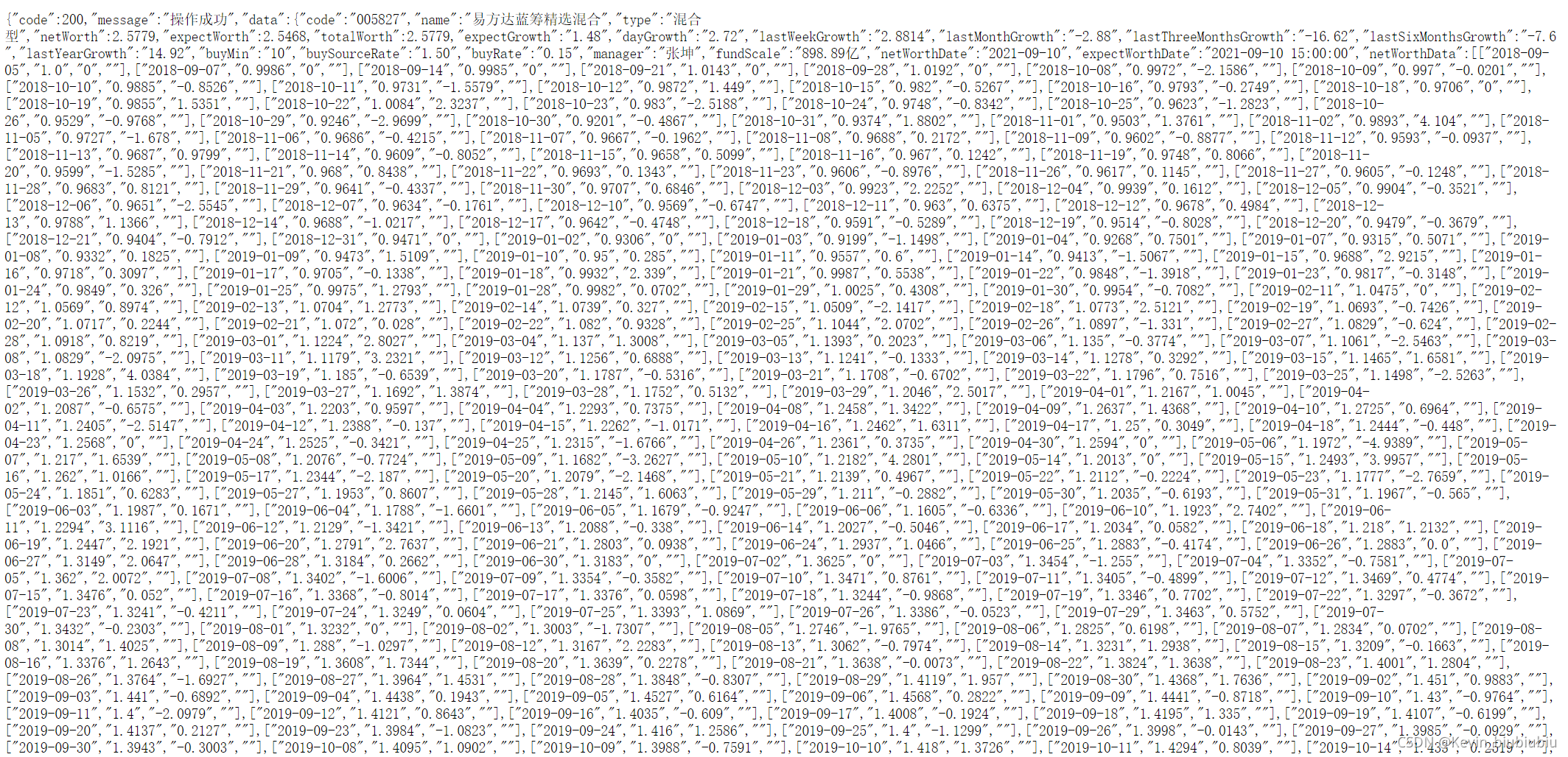这篇文章教大家如何在Python中使用免费的数据接口获取我们想要的各基金历史净值数据,以便我们进行后续的基金量化分析。
一、接口地址与格式
这里使用的接口地址是https://api.doctorxiong.club/v1/fund/detail?code=xxx,其中xxx为基金对应代号。
这里我们随便选一个例子,比如“公募一哥”张坤的易方达蓝筹精选混合,代号005827,对应的接口地址就是https://api.doctorxiong.club/v1/fund/detail?code=005827
我们用浏览器打开看看,是下面这样的数据格式:

分析结果,该接口返回的是一个字典,里面的key有"code",“message”,“data”。
其中"data"又是一个字典,里面包括该基金的各种信息和数据的key,比如"code",“name”,"manager"等等;
该基金的历史单位净值和历史累计净值数据就对应于其中的"netWorthData"和"totalNetWorthData"的key里。(大家可以自行观察一下)
二、获取数据与整理
使用到的库:
import urllib
from bs4 import BeautifulSoup
import json
import pandas as pd
先对接口地址发起请求,并利用beautifulsoup解析标签的功能来获取上面所示的文本信息。
>>> html=urllib.urlopen("https://api.doctorxiong.club/v1/fund/detail?code=005827")
>>> bsobj=BeautifulSoup(html.read())
>>> p_text = bsobj.p.get_text()
此时得到的p_text是unicode类型的文本,我们需要利用json将它转换成字典的数据类型。
>>> text_dict = json.loads(p_text)
现在我们来看一下这个字典里是不是有我们刚刚提到的各种key:
>>> print text_dict['data']['code']
005827
>>> print text_dict['data']['name']
易方达蓝筹精选混合
>>> print text_dict['data']['manager']
张坤
然后取出历史单位净值和历史累计净值,每天的数据都是以列表的形式保存,最后一个对象对应着今天的净值情况,我们输出看一看。
>>> Wdata1 = text_dict['data']['netWorthData']
>>> Wdata2 = text_dict['data']['totalNetWorthData']
>>> print Wdata1[-1]
[u'2021-09-10', u'2.5779', u'2.72', u'']
>>> print Wdata2[-1]
[u'2021-09-10', u'2.5779']
因为这个基金没有过分红派息,所以单位净值和累计净值是一样的,都是2.5779。值得注意的是单位净值里还有日涨幅率的数据,也就是上面的2.72。
最后我们把累计净值数据转换成float类型,并整体保存成DataFrame的数据类型。
>>> for i in Wdata2:
i[1] = float(i[1])
>>> Wdf = pd.DataFrame(Wdata2,columns=['Date','Worth'],dtype=float)
>>> print Wdf
Date Worth
0 2018-09-05 1.0000
1 2018-09-07 0.9986
2 2018-09-14 0.9985
3 2018-09-21 1.0143
4 2018-09-28 1.0192
5 2018-10-08 0.9972
6 2018-10-09 0.9970
7 2018-10-10 0.9885
8 2018-10-11 0.9731
9 2018-10-12 0.9872
10 2018-10-15 0.9820
11 2018-10-16 0.9793
12 2018-10-18 0.9706
13 2018-10-19 0.9855
14 2018-10-22 1.0084
15 2018-10-23 0.9830
16 2018-10-24 0.9748
17 2018-10-25 0.9623
18 2018-10-26 0.9529
19 2018-10-29 0.9246
20 2018-10-30 0.9201
21 2018-10-31 0.9374
22 2018-11-01 0.9503
23 2018-11-02 0.9893
24 2018-11-05 0.9727
25 2018-11-06 0.9686
26 2018-11-07 0.9667
27 2018-11-08 0.9688
28 2018-11-09 0.9602
29 2018-11-12 0.9593
.. ... ...
680 2021-08-02 2.5664
681 2021-08-03 2.5785
682 2021-08-04 2.5596
683 2021-08-05 2.5337
684 2021-08-06 2.5355
685 2021-08-09 2.5653
686 2021-08-10 2.6544
687 2021-08-11 2.6350
688 2021-08-12 2.5897
689 2021-08-13 2.5887
690 2021-08-16 2.5718
691 2021-08-17 2.4887
692 2021-08-18 2.5224
693 2021-08-19 2.4838
694 2021-08-20 2.4039
695 2021-08-23 2.4548
696 2021-08-24 2.5038
697 2021-08-25 2.5281
698 2021-08-26 2.4635
699 2021-08-27 2.4561
700 2021-08-30 2.4472
701 2021-08-31 2.4386
702 2021-09-01 2.5119
703 2021-09-02 2.5006
704 2021-09-03 2.5057
705 2021-09-06 2.5506
706 2021-09-07 2.5704
707 2021-09-08 2.5484
708 2021-09-09 2.5097
709 2021-09-10 2.5779
[710 rows x 2 columns]
最后的最后,,建议把"Date"转换成datetime的类型,这样方便日后放入各种量化框架中进行测试。
>>> Wdf['Date'] = pd.to_datetime(Wdf['Date'],format='%Y-%m-%d')